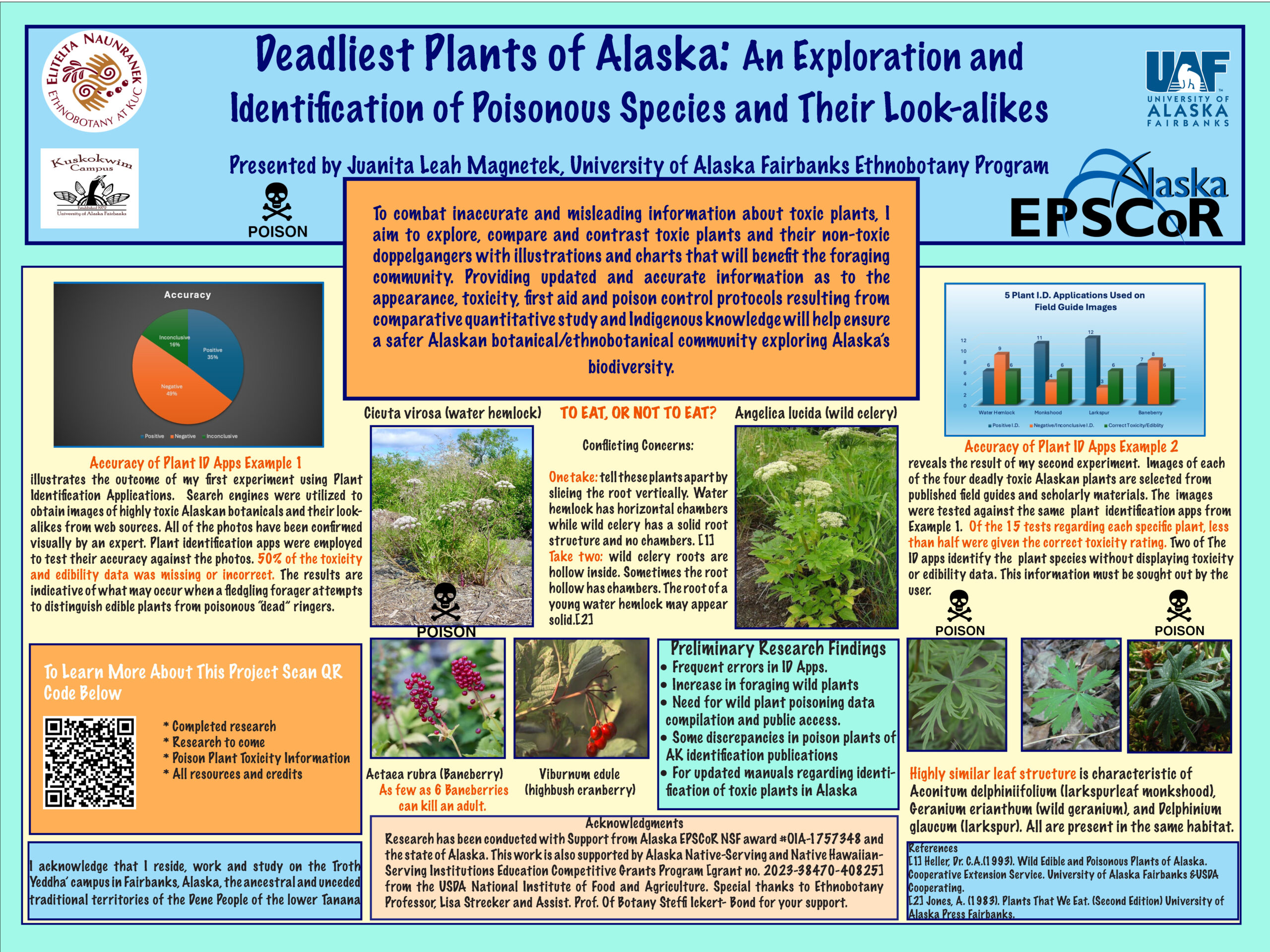
Notes For Research Poster (download poster )
UPDATE: Juanita won the WAISC 2024 Student Poster Award!
(POST IN PROGRESS, please standby)
An Exploration and Identification of Poisonous Species and Their Look-Alikes.
Abstract
To combat inaccurate and misleading information about toxic plants, I aim to explore, compare and contrast toxic plants and their non-toxic doppelgangers with illustrations and charts that will benefit the foraging community.
Providing updated and accurate information as to the appearance, toxicity, first aid and poison control protocols resulting from comparative quantitative study and Indigenous knowledge will help ensure a safer Alaskan
botanical/ethnobotanical community exploring Alaska’s biodiversity.
Introduction
(Change to reflect need for more accurate information and programs, increase in foraging. Add difficulties to obtaining what should be public access information from the poison control center. Add reference to increase in foraging scholarly articles found. Add examples of discrepancies discovered in plant ID books found. Add more detailed maps, overlays and more sources of distribution, GBIF for both toxic and non-toxic counterparts. Add examples of toxic plants on campus and surrounding communities. Continue to gain knowledge from Alaska Native Elders and stewards, as well as those working within the foraging communities in Alaska and scholars to combine for a more thorough base of information. Talk about the need for updated sources of Alaskan Plant IDs and accessible, easy to understand education for those working, playing or collecting in the Alaskan landscapes. How to avoid poisonings, how to report, how to give first aid when not in vicinity of hospitals.)


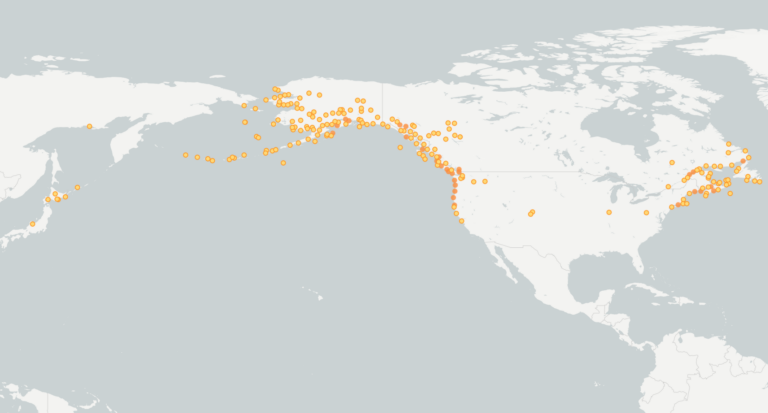
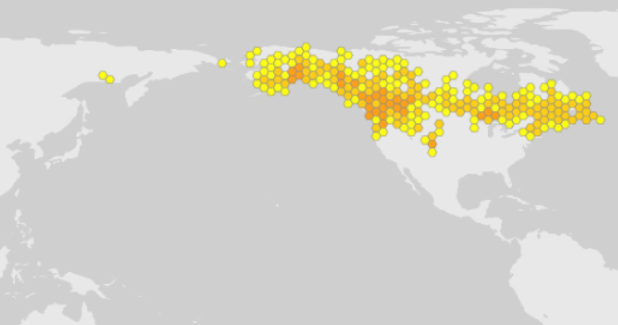
Methods
Using water hemlock, monkshood/delphinium, baneberry as examples:
1.Collect accurate data for plants
2.Collect examples in literature and online that are contradictory if found
3.test each of the selected toxic plants on various I.D. apps (create graph showing results)
4.Gather and process Poison Control Center data for Alaskan Plant Poisonings
5.Interviews with Elders on plant poisonings and how to interact and live with the plants in the natural environment traditionally
6.Develop and execute a field study to determine incidence of toxic plants in regions that are not recorded well in GBIF.
7.Develop Poisonous Plant Identification Signage and guides that are user friendly and accessible
Preliminary Findings resulting from 1-4 above are as follows
- Frequent errors in ID Apps.
- Increase in foraging wild plants
- Need for wild Alaskan plant poisoning data compilation and public access to all poisoning information.
- Some discrepancies in poison plants of AK identification publications
- Need for updated manuals regarding identification of toxic plants in Alaska
Upcoming research resumes the aforementioned methods.
Water Hemlock (Cicuta virosa, C. mackenziana, C. douglasii, C. bulbifera L.)- The Parsley Family (Apiaceae)
PUT ILLUSTRATIONS OR PHOTOS HERE. USE TRANSPARENCY ONLY IF USING DRAWING
ALL species within the Cicuta genus are deadly poisonous!
If contact is suspected, call poison control. Immediate intervention is required.
Habitat: marshes, wetlands, ponds, lakes, ditches, along streams
Toxic Plant Parts: All parts of plant are poisonous, especially the roots.
Handling of plant: Not advised. Wear gloves and mask for removal or samples. Wash all tools, skin, following exposure.
Deadly Toxin: Cicutoxin. a 17-carbon diacetylenic diol that acts as a non- competitive antagonist of Gamma-Aminobutyric acid (GABA A) receptors.
Death: within hours of ingestion.
Effects of Cicutoxin: immediate nervous system responses including nausea, stomach pain, vomiting, salivation, lockjaw, confusion, seizures and may lead to respiratory failure and death.
First Aid: Immediately induce vomiting if able. Convulsions and seizure can hinder vomiting. Seek medical care with haste!
Water hemlock can be mistaken for wild celery, wild carrot, wild parsley, and wild parsnips. All of these species are in the Apiaceae (Umbelliferae) family and have some similar attributes. Livestock and foragers alike may dig it up to eat it. This mistake can lead to toxic poisoning and possible death to both humans and animals.
Ways to distinguish water hemlock from wild celery are:
(Create side by side illustrative chart)
Continue collecting further data for all of the following:
- Presence of yellow or brownish sap or resin with a strong smell when cut. This contains the deadly toxin, Cicutoxin. It is present throughout the plant, and more so in the roots.
- Cutting the root of the plants lengthwise to check for chambers in the roots (wash your knife thoroughly afterwards!!)
- Water hemlock has distinct horizontal chambers making up the root of plant. A distinct odor is present in the root when cut. (add photo)
- Wild celery has solid root structure that is without horizontal chambers. (add photo)
- Water hemlock (C. mackenziana) in northern and interior Alaska, has long, narrow leaflets with veins that end in between the teeth of the leaf’s edges. The crushed leaves emit a strong odor, distinct to water hemlock.
- Water hemlock (C. douglasii), which may grow in central and southern Alaska, has broader leaves, which are closer in appearance to wild celery. The veins of the leaf, however, also end in the notch between the teeth of the leaf’s edge.
- Wild celery (Angelica lucida) have broad leaves with veins that extend to the pointed tip of the teeth on the leaf’s edges. The crushed leaves emit a celery-like fragrance.
- Water hemlock flowers are loose and airy umbels, made up of seven to 14 rays of approximately three inches long, topped with heads made up of many tiny white flowers.
- Wild celery flowers are a rigged and formed umbel, made up of 20 to 40 rays topped with tiny greenish-white flowers.
- Monkshood (Aconitum delphiniifolium) and Larkspur (Delphinium glaucum)- The Buttercup Family (Ranunculaceae)
Habitat: Common throughout Alaska. Meadow, forests, and moist places.
Toxic Plant Parts: Entire plant, especially root and seeds.
Handling of Plant: Not recommended. Wear gloves when handling and wash tools and hands after handling.
Deadly toxin: Aconite (Monkshood), diterpenoid alkaloids (delphinium)
Death: within hours of ingestion.
Toxic Effects: attacks central nervous system. Symptoms include numb mouth, salivation, irregular heartbeat, muscle weakness.
First Aid: Induce vomiting and seek immediate medical attention.
Monkshood and Delphinium leaves can be mistaken for wild geranium leaves, which are consumed amongst some foragers for use as salad greens or herbs. The roots of wild geranium are used mostly medicinally, as an astringent or coagulant, with uses for sore throat, childbirth, and skin troubles in some Native cultures. These three look-a-likes are all in the same plant family and have very similar leaves. The roots of delphinium have even been misidentified as parsnips. Mistaken identity can lead to a most unpleasant death within hours.
Ways to distinguish Monkshood and Delphinium from other wild plants are:
- Monkshood flowers are unique in appearance and when in bloom are the easiest way to identify this plant.
- Delphinium flowers are
- Wild geranium flowers are
- Monkshood leaves are palmately lobed and have deeply toothed edges.
- Delphinium leaves are palmate with 5 to 7 deep lobes.
- Wild geranium leaves are palmately lobed, 5-7 deep lobes.
- Monkshood roots are
- Delphinium roots are
- Wild geranium roots are
The least mistakable identification of Monkshood or Delphinium is after the flower appears. While the leaves are all similar to the wild geranium, the flowers are quite distinct.
- Baneberry (Actaea rubra, Actaea arguta) Actaea rubra (Interior) Actaea arguta (coastal)-
PUT ILLUSTRATIONS OR PHOTOS HERE. WOULD BE GOOD TO USE TRANPARENCY ONLY IF DRAWING
Habitat:
Toxic Plant Parts:
Handling of Plant:
Deadly toxin:
Death:
Toxic Effects:
First Aid:
All parts of the plant are poisonous and as few as 6 berries can cause death in an adult. Baneberry can be mistaken for high bush cranberries or other red berries. This can be a fatal error.
Ways to distinguish Baneberry from other varieties of berries are:
a.Baneberry leaves are
a.Highbush cranberry leaves are
a.Red currant leaves are
b.Baneberry fruits are
b.Highbush cranberry fruits are
b.Red currant fruits are
Baneberry is typically red, and sometimes white. There is a signature black spot or “eye” to the berry, whether it be white or red. Shiny red skin that can look like glazed porcelain gives a clue to another common name, Chinaberry.
ID App Experiment 1
Using the same 12 images of Toxic Alaskan Botanicals, selected from social media, websites, personal photos, and search engines, I will use five different A.I. Plant Identification Apps to make identifications. I will record results and compare the effectiveness of these apps for accuracy. (photos are being used in lieu of live plants due to the season at time of experiments)
*Graph these parameters:
- Positive I.D.
- Unable to I.D.
- Negative I.D.
- Correct edibility or toxicity factors
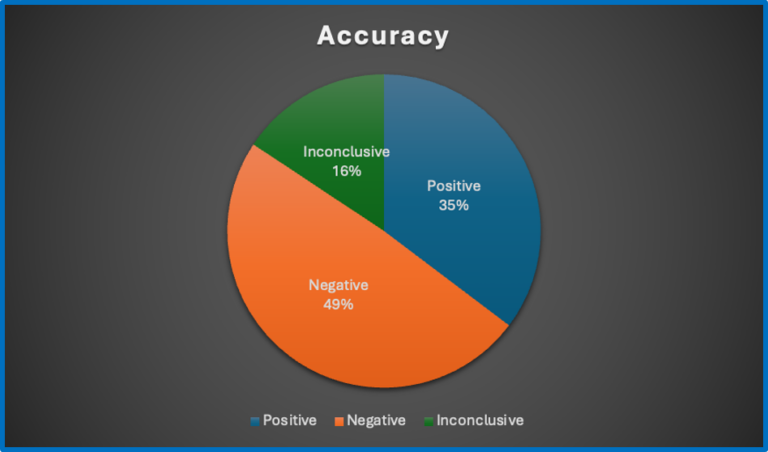
-
Angelica lucida, wild celery, cow parsnip

Photo from Alaska.org, wild celery 2 positive I.D.s, 3 negative I.D.s
- iNaturalist– top suggestion Angelica lucida (wild celery)- Apiaceae Family
- Seek– Oenanthe sarmentosa (water parsley)- Apiaceae Family. habitat western North America, wet areas and sometimes aquatic.
- Flora Incognita– Angelica lucida (seacoast angelica, sea-watch, wild celery)- Apiaceae Family. habitat most often along coastline of Atlantic, Pacific, and Arctic coasts of North America. May occur far inland in Alaska.
- PLNT– Angelica sylvestris (wild angelica, ebony angelica)- Apiaceae Family.
- Google Lens– Aegopodium podagraria (Ground Elder)- Apiaceae Family. Used historically for treatment of gout and arthritis. Leaves are used for soups and pot herbs.
Water Hemlock (Cicuta virosa)
Update: This photo has most likely been misidentified by the author (Lisa Strecker). This demonstrates the inaccuracy of some blog posts when searching for examples online.

Negative I.D.s, 5 Negative edibility/toxicity I.D.s
- iNaturalist– Anthriscus sylvestris (Cow Parsley)- other suggestions are caraway, garden chervil, common marsh-bedstraw, common yarrow, northern bedstraw.
- Seek– Apioideae family, however, cannot make species I.D. suggested taking photo at different angles. Attempted with same result.
- Flora Incognita– Anthriscus sylvestris (Cow Parsley)- Toxicity: “this plant is suspected to be poisonous to mammals. It also looks very similar to some very poisonous species so great care must be taken when identifying it.” Edible uses: “leaves are eaten raw, cooked as a potherb or used as flavoring.”
- PLNT– Anthriscus sylvestris (Cow Parsley)
- Google Lens– Carum carvi (Caraway)- fruits used as seeds or spice in rye breads or other baked goods. Eaten as herb, raw, dried or cooked.
Note: all apps considered this plant to be edible. Deadly toxic if it were Cicuta virosa.
3.Water Hemlock (Cicuta douglasii)
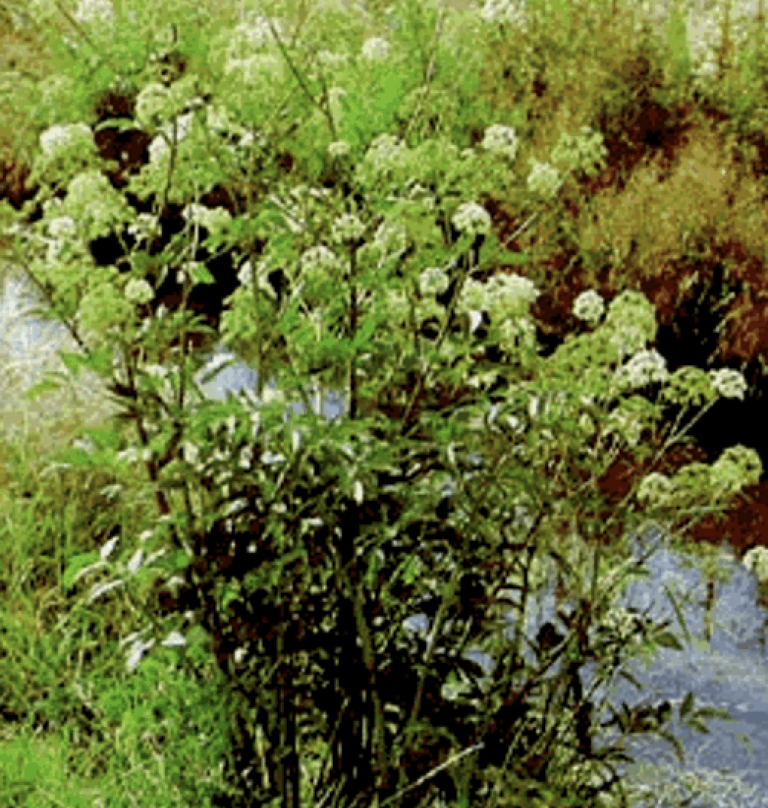
2 Negative I.D.s, 3 Inconclusive I.D.s, 2 correct edibility/toxicity I.D.s
- iNaturalist– “we are not confident enough to make a recommendation, but here are our top suggestions.” Oenanthe sarmentosa (water parsley), Ribes hudsonianum (northern black currant), Sium suave (water parsnip)
- Seek– unable to identify this photo, 5 attempts made with new photos.
- Flora Incognita– “we could not identify the species with satisfying accuracy.”
- PLNT– Oenanthe crocata (Hemlock water dropwort, water hemlock, water dropwort)- Family Apiaceae. Highly toxic to humans and animals. May be fatal if not treated promptly.
- Google Lens– Cicuta maculate (spotted water hemlock, suicide root, spotted parsley)- Apiaceae family. HIGHLY TOXIC. North America’s most poisonous plant. May result in death or permanent damage to central nervous system.
Notes: while incorrect I.D. of species, 2 correct deadly poison I.D.s
4.Water Hemlock (Cicuta virosa)
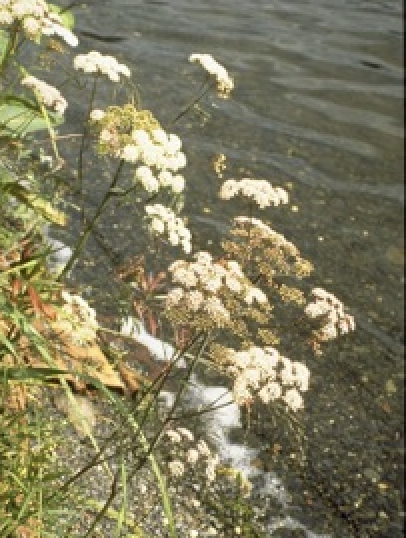
courtesy of wildflower.org
1 positive I.D., 3 negative I.D.s, 1unable to I.D., 2 positive toxicity I.D.s
- iNaturalist– Cicuta virosa (water hemlock, Cowbane). Deadly toxic.
- Seek– “we weren’t able to identify this photo.” Attempt 1- dicots attempt 2-plants- attempt 3- dicots attempt 4- plants attempt 5-carrot family.
- Flora Incognita– Achillea millefolium (yarrow). Asteraceae family. Edible and medicinal uses. Toxicity: extended use of plant medicinally or in diet may cause allergic skin rashes or photosensitivity in some people.
- PLNT– Oenanthe crocata (Hemlock water dropwort, dead man’s fingers, water hemlock, water dropwort)- Apiaceae family. Highly toxic to humans and animals.
- Google Lens– Angelica (wild celery)-used in the diet and for culinary purposes.
Attempt 2- Angelica (wild celery)- warm aromatic sweet taste.
Notes: 2 scary I.D.s stating that specimen is commonly used in diet and medicine.
5.Water Hemlock (Cicuta douglasii)

2 positive I.D.s, 2 negative I.D., 1 inconclusive I.D.s, 2 incorrect toxicity I.D.s
- iNaturalist- Genus Cicuta- top suggestions Cicuta Virosa, Cicuta Douglasii, Cicuta maculate, Sium suave. All are deadly poisonous.
- Seek- Dicots, “but could not identify exact species.”
- Flora Incognita- Cicuta douglasii (Western water hemlock)- poisonous plant in the family Apiaceae. No information as to the level of toxicity.
- PLNT- attempt 1-could not identify the plant. Attempt 2- Oenanthe crocata (Hemlock water dropwort)- Highly toxic to humans and animals.
- Google Lens- Anthriscus sylvestris (cow parsley, Queen Anne’s Lace)- edible, usually foraged and not cultivated, extreme caution advised due to confusion with poison hemlock.
Note: misidentification as Queen Anne’s Lace could prove deadly.
6.Aconitum delphiniifolium (Larkspurleaf monkshood)
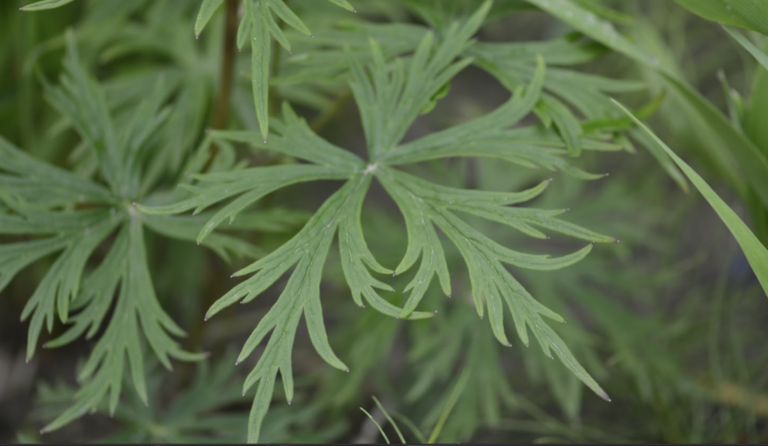
- iNaturalist- “we’re not confident enough to make a recommendation, but here are our suggestions.”- Aconitum delphiniifolium (larkspurleaf monkshood)
- Seek- “we believe this is a member of the genus ‘Geraniums and Cranesbills’.”- no specific identification.
- Flora Incognita- Aconite (Aconitum napellus)- family Ranunculaceae. AKA Monkshood, wolfsbane- whole plant is highly toxic, especially to the central nervous system. Skin contact may cause poisoning. Seek immediate medical assistance, may lead to death.
- PLNT- Consolida ajacis (Larkspur)- toxic to humans and animals if ingested. All plant parts are toxic, with seeds being particularly potent. Can be fatal if not treated promptly.
- Google Lens- Ranunculus acris (meadow buttercup)- Ranunculaceae family. Indicates toxicity when ingested. Other symptoms may be ventricular fibrillation and respiratory failure.
Notes: while unable to identify the exact species, highly toxic species were identified in the same family.
7.Larkspurleaf Monkshood (Aconitum delphiniifolium)
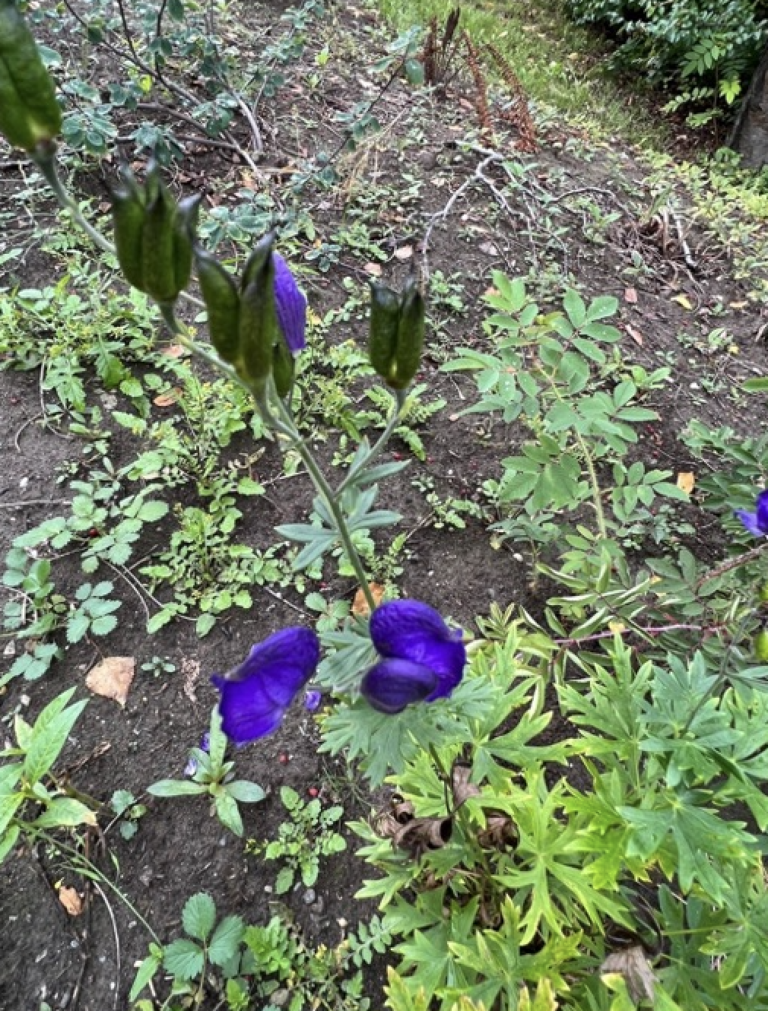
3 positive I.D.s, 2 negative I.D.s, 5 correct toxicity/edibility status.
- iNaturalist- Genus Aconitum, top suggestions: Aconitum delphiniifolium (Larkspurleaf Monkshood), Aconitum napellus (Monk’s-hood), Iris setosa (Beach-head iris), Delphinium cultorum (garden delphinium)
- Seek- after trying many angles and photos, able to make I.D.- Aconitum delphiniifolium (Larkspurleaf monkshood). No indications as to toxicity.
- Flora Incognita- Aconitum napellus (Aconite). Family Ranunculaceae. Toxicity: highly toxic and deadly to humans and animals
- PLNT- first attempt, unable to identify. Second attempt, Aconitum hemsleyanum (Chinese monkshood)- all parts of plant are highly toxic, potentially lethal to humans and ingested.
- Google Lens- first result: Aconitum delphiniifolium (Larkspurleaf monkshood)
Notes: all apps indicated deadly toxicity regardless of sometimes incorrect subspecies.
8.Wild Geranium (Geranium erianthum)
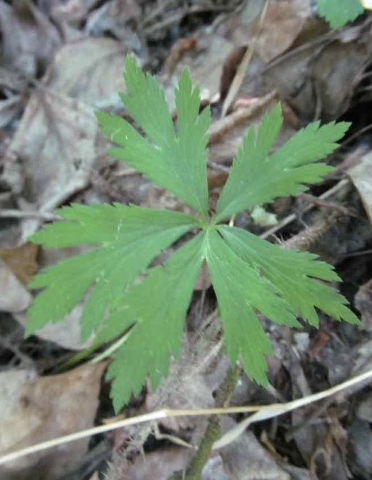
1 positive I.D., 3 negative I.D.s, 1unable to identify, 4 incorrect toxicity/edibility status.
- iNaturalist- Aconitum delphiniifolium (Larkspurleaf monkshood). Highly toxic. Do not handle or eat the plant.
- Seek- “we believe this is a member of the class Dicots.” Cannot identify the exact species.
- Flora Incognita- Trollius europaeus (Globeflower). Family Ranunculaceae. Plant is mildly poisonous unless it is dried. Observed in southern Alaska.
- PLNT- Trollius x cultorum ‘Lemon Queen’ (Globeflower). Considered mildly poisonous, recommends not to consume.
- Google Lens- Geranium maculatum (wild geranium, spotted geranium, wood geranium). Used in herbal medicine. Edible.
Note: incorrect subspecies of Geranium identified, however, it has the same basic qualities and toxicity
9.Baneberry (Actaea rubra)

Actaea rubra flower. Courtesy of wikipedia.org
3 positive I.D.s, 1 negative I.D., 1 inability to I.D., 3 accurate toxicities
- iNaturalist- Actaea rubra (red baneberry)- family Ranunculaceae. Toxicity: in humans can lead to cardiac arrest and death if eaten.
- Seek- Trautvetteria caroliniensis (Carolina bugbane)- Ranunculaceae family. No toxicity information.
- Flora Incognita- “we could not find species with satisfying accuracy.” Attempted x3.
- PLNT- Actaea rubra (Red baneberry)- family Ranunculaceae. Toxicity: entire plant is poisonous to humans. Ingestion may lead to respiratory distress, cardiac complications and if enough is eaten, death.
- Google Lens- Actaea rubra (Red baneberry)- family Ranunculaceae. All plant parts are poisonous. 2 berries can kill a child. An adult can experience poisoning from as few as 6 berries. Seek immediate medical attention.
Notes: more accuracy than other species.
10.High bush cranberry (Viburnum edule)

positive I.D.s, 1 unsuccessful I.D., 4 accurate edibility/toxicity status
- iNaturalist- Viburnum edule (squashberry, highbush cranberry, mooseberry)- highly edible and widespread in Alaska. Many edible uses and no toxicity.
- Seek- Viburnum edule (squashberry, highbush cranberry)- family Viburaceae. Common to this area of Alaska.
- Flora Incognita- Viburnum edule (squashberry)- toxicity: recommends cooking due to high quantities of fresh berries causing stomach upset in some people. Edible.
- PLNT- could not identify this plant. Attempted x3.
- Google Lens- Viburnum edule (Highbush Cranberry)- species is indigenous to North America. Highly edible. Similar flavor to cranberry on tall shrubs.
Note: high success rate identifying
ID App Experiment 2
Now, let’s use guidebook and classroom educational photos to test the 5 apps.
Guides used:
-Discovering Wild Plants Alaska, Western Canada, The Northwest by Janice Schofield. 1989
-Handbook of Poisonous and Injurious Plants by Lewis S. Nelson, M.D., Richard D. Shih, M.D., and Michael J. Balick, Ph.D. 2007
-Wild Edible and Poisonous Plants of Alaska, Cooperative Extension Service, University of Alaska Fairbanks & USDA Cooperating last revises 1993
-when no photo available in guide, personal photos of Lisa Strecker and Juanita Magnetek used, taken in Alaska.
Example 2
Example 2 illustrates the result of my second experiment. Three images of each of the four deadly toxic Alaskan plants are selected from published field guides and scholarly materials. These images are then tested against the same five plant identification applications from Example 1. Of the 15 tests regarding each specific plant, less than half were given the correct toxicity rating. These numbers are in part due to the lack of toxicity given on two of the applications. These apps identify the plant species without displaying toxicity or edibility information. This information must be sought out by the user, if not already known.

EXAMPLE 2 DATA COLLECTION
water hemlock photos:
- Discovering Wild Plants… pg 46
- iNaturalist- “we’re not confident enough to make a recommendation, but here are our suggestions.” First suggestion: common yarrow (Achillea millefolium). no toxicity displayed.
- Seek- negative I.D. Asclepias fascicularis (Narrowleaf milkweed). no toxicity displayed.
- Flora Incognita- positive I.D. Cicuta virosa (cowbane). Highly toxic. death due to respiratory paralysis.
- PLNT- negative I.D. Angelica gigas (Korean angelica). non-toxic to humans.
- Google Lens- unable to identify.
- Handbook of Poisonous…pg 123
- iNaturalist- positive I.D. Genus Cicuta (water hemlocks). The top suggestion is Cicuta maculata. no toxicity displayed.
- Seek- negative I.D. Valeriana officinalis (common valerian)- no toxicity displayed.
- Flora Incognito- positive I.D. Cicuta maculata (spotted water hemlock). no toxicity displayed.
- PLNT- negative I.D. after 2 attempts, unable to I.D. Oenanthe crocata (hemlock water dropwort, water dropwort) correct Family Apiaceae. Correct toxicity can be fatal.
- Google Lens- positive I.D. Cicuta maculata (spotted cowbane). Fatal if not treated swiftly.
- Cicuta mackenziana (C. virosa) back cover of Wild Edible and…
- iNaturalist- positive I.D. Genus Cicuta. The top suggestion is Cicuta virosa (Cowbane). no toxicity displayed.
- Seek- negative I.D. Angelica sylvestris (wild angelica). no toxicity displayed.
- Flora Incognito- positive I.D. Cicuta virosa (Cowbane). toxicity is a very poisonous plant , even a small bite can be lethal.
- PLNT- negative I.D. Oenanthe crocata (hemlock water dropwort). correct toxicity, though not as potent. severe poisoning can lead to death.
- Google Lens- no I.D. positively made. suggestions include Cicuta virosa, however, gives more common preference to several Valerian images/sites. toxicity must be sought and is not displayed.
***results: positive I.D.s 6, negative or inconclusive I.D.s 9, correct toxicity 6 of 15
monkshood photos
1.Discovering Wild Plants… pg 167
- iNaturalist- positive I.D. Larkspurleaf Monkshood (Aconitum delphiniifolium)
- Seek- positive I.D. Larkspurleaf Monkshood (Aconitum delphiniifolium)
- Flora Incognita- positive genus- Aconite. Aconitum napellus agg. entire plant is highly toxic, may cause respiratory failure and death
- PLNT- negative I.D. Delphinium. toxicity: contains toxic alkaloids. poisonous to humans if ingested. may result in death.
- Google Lens- positive genus- Aconite. Aconitum variegatum. Highly toxic, contains aconite, may lead to death
2.Handbook of Poisonous…pg 61
- iNaturalist- positive Tribe Delphinieae- top suggestion Delphinium cultorum (garden delphinium) but also suggests Acontum delphiniifolium and other Aconite. no toxicity info displayed.
- Seek- positive Genus Monkshoods. could not identify species. no toxicity info displayed.
- Flora Incognita- positive genus- Aconite. Aconitum napellus agg. entire plant is highly toxic, may cause respiratory failure and death
- PLNT- negative I.D. Delphinium. toxicity: contains toxic alkaloids. poisonous to humans if ingested. may result in death.
- Google Lens- negative I.D., no specific result. suggestions of similar images. attempted x3. Most images were of a variety of monkshood species, some delphinium
- Aconitum delphiniifolium image by Professor Lisa Strecker
- iNaturalist- Genus Aconitum. Positive I.D. with suggestion for Larkspurleaf Monkshood as species. No toxicity displayed.
- Seek- positive I.D. for Genus Aconitum. incorrect species. Aconitum columbianum. No toxicity displayed.
- Flora Incognita- negative I.D. Geranium columbinum (Long-stalked crane’s-bill)
toxicity: none displayed.
- PLNT- positive I.D. for Genus Aconitum. incorrect species. Aconitum hemsleyanum. toxicity: “sorry, but this content is still in progress…” unavailable.
- Google Lens- positive Genus Aconitum. incorrect species. Aconitum variegatum. wrong habitat. potent neurotoxin aconite. may lead to death.
*** results: positive I.D.s 11, negative I.D.s inconclusive I.D.s 4, correct toxicity 6 of 15
Delphinium photos
- Discovering Wild Plants…pg 167
- iNaturalist- positive I.D. of Genus Delphinium. The first suggestion is positive, Delphinium glaucum. no toxicity displayed.
- Seek- attempts x4 resulted in positive I.D. of Delphinium glaucum. no toxicity displayed.
- Flora Incognita- positive I.D. of Delphinium glaucum (Sierra larkspur) toxicity: all plant parts are toxic, especially when young.
- PLNT- unable to I.D. attempted x3
- Google Lens- negative I.D., no specific result. suggestions of similar images. attempted x3. Most images were of a variety of monkshood species, some delphinium
- Larkspur from personal images of Professor Lisa Strecker
- iNaturalist- positive I.D. Genus Delphinium. The top suggestion is Delphinium glaucum. no toxicity displayed.
- Seek- negative I.D. Aconitum napellus (monkshood, aconite, wolfsbane). toxicity is not displayed.
- Flora Incognita- positive I.D. Genus Delphinium. incorrect species. Delphinium elatum. all parts of the plant are toxic, especially when young. correct toxicity.
- PLNT- positive I.D. of Genus Delphinium. no species specified. toxicity- all parts of plants are toxic, can lead to death in severe cases of poisoning.
- Google Lens- positive I.D. Genus Delphinium. unclear as to species, several displayed. no toxicity displayed.
- Delphinium glaucum personal field photo taken 2023 by Juanita Magnetek.
- iNaturalist- positive I.D. Genus Delphinium (larkspurs). top suggestion of species incorrect. Delphinium cultorum (garden delphinium). no toxicity displayed.
- Seek- positive I.D. of Genus Delphinium. “couldn’t identify the exact species.” no toxicity displayed.
- Flora Incognita- positive I.D. of Genus Delphinium. incorrect species of Delphinium elatum. toxicity: “all parts of the plant are toxic. The plant is most toxic when young.”
- PLNT- positive I.D. of Genus Delphinium (Larkspur). poisonous if ingested. all parts of the plant contain alkaloids. In severe cases, it may cause death.
- Google Lens- positive I.D. of Genus Delphinium. incorrect species of Delphinium trolliifolium.” toxic to livestock. Most larkspur species are toxic to some degree.”
***results: positive I.D.s of 12, negative I.D.s 3, correct toxicity 6 of 15
baneberry photos
- Discovering Wild Plants…pg 77 (top photo of plant with berries)
- iNaturalist- positive I.D. as Genus Actaea. top suggestion is Actaea rubra (red baneberry). no toxicity displayed.
- Seek- positive I.D. as Actaea rubra (red baneberry). toxicity described as “poisonous herbaceous flowering plant.”
- Flora Incognita- positive I.D. as Actaea rubra (red baneberry). toxicity: “all parts of the plant are toxic, apparently acting upon the heart.”
- PLNT- positive I.D. as Actaea rubra (red baneberry). toxicity: all plant parts are toxic. “Severe cases can lead to critical condition if a significant quantity has been consumed.”
- Google Lens- negative I.D. inconclusive. bringing up images of berries on branches for art and wall decor. photo taken x3. toxicity null.
- Discovering Wild Plants…pg 77 ( bottom photo of shoots)
- iNaturalist- negative I.D. “We are not confident enough to make a recommendation.” The top suggestion is Microglossum viride (Green Earthtongue) with no toxicity displayed.
- Seek- negative I.D. unable to identify. no toxicity to display.
- Flora Incognita- negative I.D. “ we could not identify the species with satisfying accuracy.”
- PLNT- negative I.D. Thalictrum aquilegiifolium (meadow rue). toxicity: not considered to be highly toxic to humans or animals. may cause gastrointestinal upset if consumed in large quantities.
- Google Lens- negative I.D. Fiddlehead or fiddlehead greens. highly edible and used as vegetable or pickled.
- Handbook of Poisonous…pg 63 (Actaea rubra)
- iNaturalist- positive I.D. of Genus Actaea, but has suggestions of Rubus spectabilis (salmonberry), Ribes rubrum (red currant) and Rubus arcticus (Arctic raspberry) below the top suggestion of red baneberry. This may cause confusion.
- Seek- Positive I.D. Actaea rubra (red baneberry). poisonous herbaceous flowering plant
- Flora Incognita- Positive I.D. for Actaea rubra (red baneberry). toxicity all parts of the plant are poisonous.
- PLNT- negative I.D. “We couldn’t identify this plant.”
- Google Lens- positive I.D. for Actaea rubra (red baneberry). toxicity: can cause cardiac arrest in large enough quantities. poisoning not likely due to bitterness of berries.
*** results: positive I.D.s 7, negative I.D.s 8, correct toxicity 6 of 15





